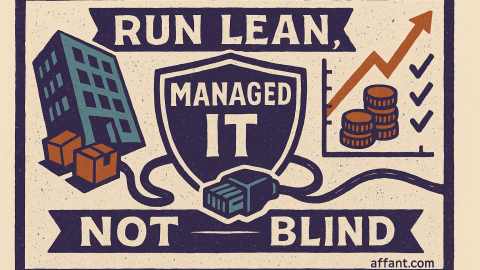Before Go-Live: The Handoff That Sets the Tone
The handoff starts before anything “goes live.” A good partner doesn’t show up with software; they show up with questions. Who uses what, where the work really happens, which apps are touchy, which vendors are helpful, and which ones make you wait on hold. You meet one person who will steer the relationship, not a rotating cast of ticket numbers. There’s a short plan you can explain to a non-technical executive without taking a breath, and a calendar that respects payroll week and the product launch circled in red. Nothing dramatic, just the sense that someone is going to drive the same route you do and signal before they turn.
Month 1: Making the Invisible Visible
The first month is about making the invisible visible. Devices start checking in, not because it is fancy, but because it makes problems findable in daylight instead of at 2 a.m. Backups are not just “green” on a dashboard; someone proves a restore works and writes down how they did it. You stop answering the question “where does this live?” because the map is right there—laptops, servers, apps, renewals, the oddball scanner that only behaves if you whisper to it. Support feels different too. Requests land in a queue with names and times attached, and the updates read like a person wrote them. You notice it in small ways: fewer emails that begin with “following up,” fewer mystery charges for seats no one uses, fewer late-night favors.
Month 2: When the Noise Drops
By the second month the noise drops. Password resets are still a thing, because people are people, but the repeat offenders—the laptop that reboots on Tuesdays, the shared drive that disappears when someone prints, the switch that sulks when marketing uploads a video—those stop being regulars. Onboarding becomes a simple ritual: the laptop arrives, the accounts work, MFA is there from the start, the person actually gets to meet their manager on day one instead of wrestling with a password. Offboarding stops being a scavenger hunt. Doors close when they should, files and calendars move to the right place, licenses return to the pool, and a small note lands in finance that explains why the number went down this month.
Vendor calls change character. The partner rings the carrier or the SaaS provider and brings logs and diagrams instead of guesswork. “It’s not us” is no longer the end of the conversation; it is the beginning of a trace that ends with a fix. Your own team starts to feel the space open up. The engineer who was everyone’s unofficial help desk gets back to product work. The office manager stops playing switchboard for support. Leaders notice that updates are shorter and clearer—what happened, what changed, what you saved—without a ten-slide appendix.
Month 3: Quiet Confidence
Month three settles into something like quiet confidence. The review meeting takes fifteen minutes and feels familiar: the uptime for the apps that matter, how quickly people got help, which devices fell behind on updates and how many are already caught up, where the backup test succeeded and what changed because of it. You can point to dollars, too—seats you stopped paying for, cloud resources that now sleep at night, the absence of an after-hours invoice that used to arrive every other Friday. Most importantly, the language shifts from “we think” to “here’s what we saw,” because instrumentation and ownership make opinions unnecessary.
Boundaries: What Stays With You vs. What Shifts to the Partner
Along the way you learn what a healthy boundary looks like. Your partner is not there to rename your departments or choose your ERP; they are there to keep the undifferentiated heavy lifting from eating your week. Help desk, device care, patching, monitoring, backups, routine access changes, the small network moves that should not require a war room, and the after-hours call you would rather not answer—that is their lane. You keep the pieces that define you: strategy, vendor selection, the industry-specific systems where your knowledge is the advantage. Co-managed if you like to steer, fully managed if you prefer to ride—either way, the goal is time back for the work only your team can do.
Green Flags: Signs You Picked Well
They ask how you make money before they recommend a tool. They write things down where you can see them—network maps, run notes, contacts, the “this is how we actually do it here” details that make Tuesday easier. If something matters, it has a metric; if it has a metric, someone owns it. They standardize builds so success does not depend on which tech touched it last. And they are comfortable saying no to shortcuts that save a minute now and cost you a weekend later.
Red Flags: Signals to Reset the Plan
Reports that sparkle while users grumble. “All-inclusive” until 5:01 p.m., then the fine print appears. A forced stack of tools that pads a partner program more than it helps your team. Replies from “Service Desk” with no human you can hold accountable. Basic hygiene—backups, patching, onboarding—treated as add-ons. If you see those, you do not need a confrontation. You need a new plan.
The Invoice: A Receipt for the Calm You Felt
What should the invoice look like at the end of the month? Familiar. A story you already heard in the review: how many people you supported and why the number moved, which tools are included and the point of each, the project that started and finished, any credits if targets slipped, and the savings you captured since last time. No scavenger hunt. No gotchas. Just a receipt for the calm you felt.
Why Leaders Outside IT Should Care
Managed services are not “outsourcing tickets.” They are schedule protection and reputation insurance. The quiet daily work is what prevents the outages and security stories that derail quarters. Finance cares because spend becomes predictable. HR cares because new hires start working on day one. Sales cares because demos do not implode at 10 a.m. And leadership cares because the machine hums without demanding applause.
Where Affant Fits
Affant sits in the practical parts. We make what you have visible, stop the waste you can measure, take on the routine so your team can focus, and leave artifacts leaders and auditors can read without translation. Some clients want a light co-managed rhythm; others want fully managed coverage with a tight scope. The pace is yours. The proof is in the small, steady changes you can feel by week two and measure by month three.
Bottom Line
The first 90 days with a managed IT partner should not feel like a leap. It should feel like exhaling. Fewer fires. Cleaner spend. A support rhythm that lets your people get back to building the business. If that is the outcome you want, this is what it looks like when it is working.











